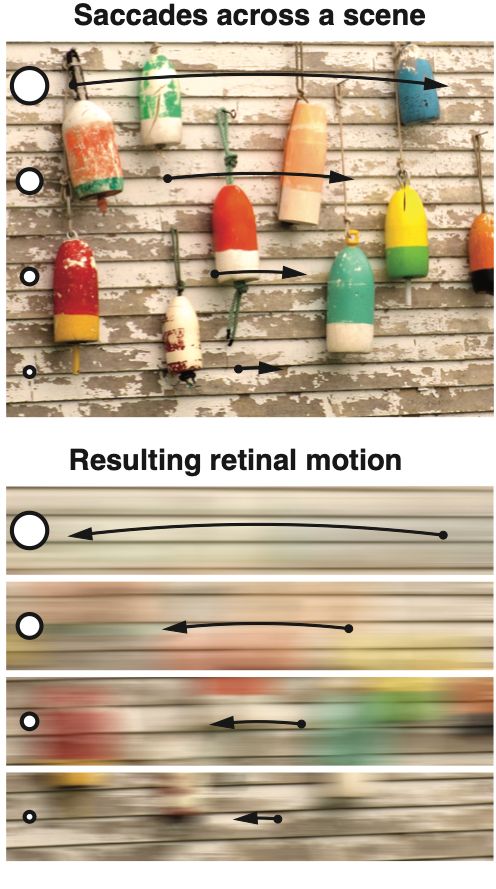It was great to have you here!
18.07.2025 19:30 — 👍 1 🔁 0 💬 0 📌 0

PhD position — Rademaker lab
Curious about the visual human brain, a vibrant and collaborative lab, and pursuing a PhD in the heart of Europe? My lab is recruiting for a 3-year PhD position. More details: www.rademakerlab.com/job-add
01.07.2025 06:43 — 👍 47 🔁 46 💬 1 📌 4
"Lawful kinematics link eye movements to the limits of high-speed perception" now out in @natcomms.nature.com.
Here is the link to the paper: rdcu.be/enLiB
You find a detailed thread below!
26.05.2025 15:09 — 👍 9 🔁 2 💬 0 📌 0

Big shoutout to my co-authors Richard Schweitzer, Éric Castet, Tamara Watson, & @svenohl.bsky.social. I want to thank more people than I can list here (see screenshot). And we are grateful for continued funding from @dfg.de , @erc.europa.eu , @daadworldwide.bsky.social over the past few years! 15/15
26.05.2025 14:58 — 👍 2 🔁 0 💬 0 📌 0

We show that a parsimonious model of early visual processing captures both the phenomenology of and sensitivity to high-speed stimulus perception in our task. It gives rise to perceptual omission of saccade-induced motion while maintaining sensitivity to high-speed motion.13/n
26.05.2025 14:58 — 👍 1 🔁 0 💬 1 📌 0
Second, saccade speeds vary across observers and we see consistent & specific covariations with individual visibility thresholds: An individual’s velocity of leftward saccades (which entail rightward retinal motion) predicted thresholds for rightward motion and vice versa. 12/n
26.05.2025 14:58 — 👍 0 🔁 0 💬 1 📌 0

a cartoon character with glasses and a mustache is saying `` coincidence ? '' .
ALT: a cartoon character with glasses and a mustache is saying `` coincidence ? '' .
We believe that this relation is not coincidental. First, we show that this relation holds only if the stimulus has static movement endpoints—as little as 13 ms are enough—much like the fixated image before and after a saccade induces saccadic omission. 11/n
26.05.2025 14:58 — 👍 0 🔁 0 💬 1 📌 0
That means that the high-speed stimulus was more visible when moving over larger distances. But this is not a consequence of longer movement durations: The shorter the motion path, the shorter the movement duration can be to render the stimulus visible. 10/n
26.05.2025 14:58 — 👍 0 🔁 0 💬 1 📌 0

… instead, visibility of continuous motion depends on a conjunction of the speed, duration, and amplitude of the movement and is exactly proportional to the main sequence of saccades. Plotting speed and duration thresholds as a function of amplitude shows this relationship. 9/n
26.05.2025 14:58 — 👍 1 🔁 0 💬 1 📌 0
At high speeds, this task becomes impossible to do, as the (physically continuous) motion looks just like a sudden displacement. The exciting finding regards the threshold at which motion becomes invisible: It is not simply a function of the speed or duration of the stimulus... 8/n
26.05.2025 14:58 — 👍 0 🔁 0 💬 1 📌 0
We used @vpixx.bsky.social's PROPixx for high-speed video projection to reproduce the lawful saccadic conjunction of speed/duration/amplitude in a moving stimulus, and assessed observers’ ability to see the stimulus’ motion by asking them if the stimulus moved with an up- vs downwards curvature. 7/n
26.05.2025 14:58 — 👍 3 🔁 1 💬 1 📌 0
The key prediction was now that the kinematics of saccades—as defined by the main sequence—impose a limit on the ability to perceive motion even in the absence of saccades. That is, we predicted that stimuli that rapidly change place when observers fixate their gaze should become invisible. 6/n
26.05.2025 14:58 — 👍 0 🔁 0 💬 1 📌 0

Saccadic omission revisited: What saccade-induced smear looks like
During active visual exploration, saccadic eye movements rapidly shift the visual image across the human retina. Although these high-speed shifts occur at a high rate and introduce considerable amount...
The saccade-induced retinal motion is subjectively invisible during natural vision; we call that saccadic omission. (We have some other work that investigates the [purely visual] natural-scene properties that drive saccadic omission in detail: doi.org/10.1101/2023... – more on that another time) 5/n
26.05.2025 14:58 — 👍 0 🔁 0 💬 1 📌 0

The kinematic law that governs saccade-induced motion on the retina is called the main sequence, and describes the relation of saccade speed and duration to the movement's amplitude: both peak velocity and duration of the movement increase systematically with the distance the eyes travel. 4/n
26.05.2025 14:58 — 👍 1 🔁 0 💬 1 📌 0

Saccadic eye movements incessantly impose rapid motion on the retina. We hypothesized that this abundance of input may shape if and how we perceive high-speed motion even during fixation. Importantly, the kinematics of saccade-imposed retinal motion are very systematic. In fact, they are lawful.
26.05.2025 14:58 — 👍 0 🔁 0 💬 1 📌 0

a close up of a cartoon character with red eyes .
ALT: a close up of a cartoon character with red eyes .
"Lawful kinematics link eye movements to the limits of high-speed perception" finally out in @natcomms.nature.com! We started this work back in 2016 when Eric Castet & Tamara Watson visited my (then young) lab. This work is close to my heart & supported by a @erc.europa.eu Consolidator Grant. A🧵 1/n
26.05.2025 14:58 — 👍 6 🔁 1 💬 1 📌 1
2/n Sven Ohl, Martin Rolfs (@rolfslab.bsky.social), and I investigated how intention modulates awareness of one of the smallest human actions: microsaccades—tiny eye movements typically generated spontaneously during fixation.
17.05.2025 21:48 — 👍 2 🔁 1 💬 1 📌 0

Postdoctoral research fellow (m/f/d) - E 13 TV-L- Visual Information Sampling at Science of Intellig...
We're looking for: Postdoctoral research fellow (m/f/d) - E 13 TV-L- Visual Information Sampling (Full Time) • Marchstraße 23, Berlin, 10587, Deutschland
New postdoc position on visual information sampling at our Science of Intelligence cluster. If you have a strong experimental background in eye movements/ active vision/ cognitive science & would like to do a postdoc for 20 months in Berlin, please shoot me a message or simply apply!
t.co/jo7v8s7awL
20.11.2023 09:50 — 👍 5 🔁 5 💬 0 📌 0
PhD student @HumboldtUni and @MindaBrain | studying active perception and cognition in the @rolfslab | 1st Gen | he/him
i am a cognitive scientist working on auditory perception at the University of Auckland and the Yale Child Study Center 🇳🇿🇺🇸🇫🇷🇨🇦
lab: themusiclab.org
personal: mehr.nz
intro to my research: youtu.be/-vJ7Jygr1eg
Assistant Professor
Psychological and Brain Sciences
University of Toronto Mississauga
Co-Director, APPLY Lab (www.applylab.org)
Least important mammal in his house (just ask the cats).
"If vision worked like *that*, we'd all be dead."
(Applied) Cognitive Psychologist; Professor @ The George Washington University; Visual search, individual differences, training, big data; http://mitrofflab.org/
Lecturer (Assistant Prof) at @abdnpsych.bsky.social (🏴🇬🇧), previously 🇺🇸🇨🇭🇮🇹 | Into Perception! 👁️🧠: crowding, serial dependence, medical image perception | lab website https://www.manassilab.com/
Psychologist and neuroscientist. Studying how we perceive, act and decide
Reader (Associate Professor) - Birkbeck, University of London
https://psyc.bbk.ac.uk/uncertainty/
Cognitive (Neuro)scientist. Professor and Dean of Faculty of Psych. Uni. of Iceland. PI of the Icelandic Vision Lab (visionlab.is). I like brains and lipstick. Weird is good. Alt account: @icevislab.bsky.social
Associate Professor in Cognitive Psychology at the University of Bergen, Norway. I study decision-making and biases in perception and visual working memory, with occasional forays into higher level decisions. https://andreychetverikov.org
Vision scientist in Experimental Psychology, University College London. Foreigner. Father. Posting perception, neuroscience, music & I guess reposted memes. He/him. Lab website: http://eccentricvision.com
Vision Scientist, Dad, Would-be artist & dreadful chess player. Check out my new #visionscience textbook here: https://www.routledge.com/Practical-Vision-Science-Learning-Through-Experimentation/Balas/p/book/9781032691121 All opinions my own.
Assistant Professor of Psychology at The New School in NYC studying visual perception and cognition: https://scholar.google.com/citations?hl=en&user=99SDXHoAAAAJ&view_op=list_works&sortby=pubdate
Cognitive scientist at Barnard College; visual categorization; EEG; eye movements; machine learning; childless cat fae; will ask to see a picture of your pet. Opinions my own. They/she. 🏳️🌈
Assistant Professor at Rice University studying attention and working memory. Also likes: speculative fiction, long dog walks, & food adventures. (she/her)
Creating & writing about data vis for @datawrapper.de
Associate Professor
Psychology and Wisconsin Institute for Discovery
University of Wisconsin-Madison
Cognitive neuroscience professor, sustainability advocate, Columbus Crew fan. Opinions my own. He/him
Cognitive neuroscientist, parent, mentor, advocate, soccer lover; Professor of Psychology at Ohio State Univ, lab website: https://u.osu.edu/golomblab/
Vision scientists and horror film enthusiast.
I also lecture at the University of the Sunshine Coast when I'm not at the beach.
Proud graduate of Forest Hills High School (NYC) whose reading careens wildly among neuroscience, Tudor/Stuart history, and Carl Hiaasen.












